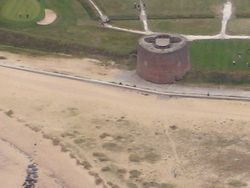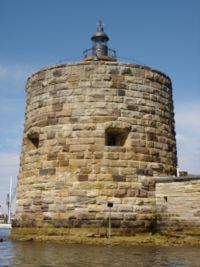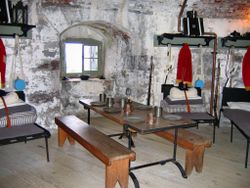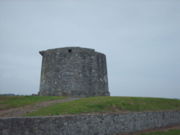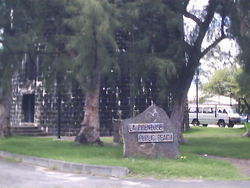Martello tower
2007 Schools Wikipedia Selection. Related subjects: British History 1750-1900
Martello towers (or simply Martellos) are small defensive forts built by the British Empire during the 19th century, from the time of the Napoleonic Wars onwards. They stand about 40 feet (12m) high (with two floors) and had a garrison of one officer and 25 men. Their round structure and thick walls of solid masonry made them very resistant to cannon fire, while their height made them an ideal platform for a single heavy artillery piece, mounted on the flat roof and able to traverse a 360° arc. A few Martello towers were surrounded by a moat for extra defence. They were used throughout the 19th century, but became obsolete with the introduction of powerful rifled artillery. Many have survived to the present day, often being preserved as historic monuments.
Origins
Martello towers were inspired by a round fortress, part of a larger Genovese defense system, at Mortella Point in Corsica (see picture here). Since the 15th century, similar towers had been built at strategic points around Corsica to protect coastal villages and shipping from North African pirates. They stood one or two stories high and measured 12-15 m (36-45 ft) in diameter, with a single doorway 5 m off the ground that could only be reached by climbing a removable ladder. The towers were paid for by local villagers and staffed by watchmen (known as torregiani) who would signal the approach of unexpected ships by lighting a fire on the tower's roof. This would alert the local defence forces to the incoming threat. Although the pirate threat subsequently dwindled, the Genoese built a newer generation of circular towers which were used to ward off later foreign invasions.
On 7 February 1794, the tower at Mortella Point was attacked by two British warships, HMS Fortitude (74 guns) and HMS Juno (32 guns) and was eventually captured by land-based forces under Sir John Moore after two days of heavy fighting. Vice-Admiral Lord Hood reported:
- The Fortitude and Juno were ordered against it, without making the least impression by a continued cannonade of two hours and a half; and the former ship being very much damaged by red-hot shot, both hauled off. The walls of the Tower were of a prodigious thickness, and the parapet, where there were two eighteen-pounders, was lined with bass junk, five feet from the walls, and filled up with sand; and although it was cannonaded from the Height for two days, within 150 yards, and appeared in a very shattered state, the enemy still held out; but a few hot shot setting fire to the bass, made them call for quarter. The number of men in the Tower were 33; only two were wounded, and those mortally.
The British were impressed by the effectiveness of the tower against their most modern warships and copied the design. However, they got the name wrong, misspelling "Mortella" as "Martello".
Martello towers in the British Isles
Between 1804 and 1812 the British authorities built a chain of similar structures to defend the south and east coast of England, Ireland, Jersey and Guernsey to guard against possible invasion from France. 105 were built in England, set at intervals along the coast from Seaford, Sussex, to Aldeburgh, Suffolk. Most were constructed under the direction of General William Twiss ( 1745– 1827) and a Captain Ford.
The interior of a Martello tower was divided into three stories. The ground floor served as the magazine and storerooms, where ammunition, stores and provisions were kept. The garrison of 24 men and one officer lived on the first floor, which was divided into several rooms and had fireplaces built into the walls for cooking and heating. The roof or third floor was surmounted with one or two cannon capable of turning through up to 360 degrees. A well or cistern was provided within the fort to supply the garrison with fresh water.
The effectiveness of Britain's Martello towers was never actually tested in combat against a Napoleonic invasion fleet. After the Napoleonic threat had passed, the Martello towers in England met a variety of fates. Many were taken over by the Coastguard to aid in the fight against smuggling. Fifteen towers were demolished to re-use their masonry. Thirty were washed away by the sea, while four more were destroyed by the military in experiments to test the effectiveness of the new rifled artillery. During the Second World War, some Martello towers returned to military service to serve as observation platforms and firing platforms for anti-aircraft artillery. Forty-seven have survived in England, of which a few have been restored and transformed into museums (as in the case of the tower at St Osyth), visitor centres, and galleries (such as Jaywick Martello Tower). Many are privately owned or private residences and the remainder are derelict.
Martello towers elsewhere
Martello towers were exported to many colonies of the British Empire, including South Africa (at Simon's Town Naval base near Cape Town and a rare inland example in Fort Beaufort), America, Canada, Minorca, the Channel Islands and Ireland. The construction of Martello towers abroad continued until as late as the 1860s, but was discontinued after it became clear that they could not withstand rifled artillery weapons.
France built similar towers along its own coastline, which they used as platforms for communication by optical telegraphs (using the Chappe Telegraph). The United States government also built Martello towers along the east coast of the US, copying the British design with some modifications.
Australia
The last Martello tower built in the British Empire is said to be that at Fort Denison, a small island in Sydney Harbour, New South Wales. It was built to protect Sydney against the threat of a naval attack by the Russians during the Crimean War of the 1850s. It is well preserved and is now a popular tourist attraction.
Barbuda
There is a Martello tower on the island of Barbuda in the West Indies. It is attached to a pre-existing fort, probably built by the Spanish. It was used to guard the Southwest of the island, and is located approximately seven miles south of the island's main village at Codrington.
Bermuda
There is a Martello tower located at Ferry Reach in St George's Parish. It was completed in the 1820s.
Canada
A total of sixteen Martello towers were built in Canada, of which eleven are still standing. Canadian Martello towers were built with removable cone-shaped roofs to protect against snow, and many of the restored towers now have permanent roof additions - for ease of upkeep, not historical accuracy.
The oldest martello-style tower in North America is the Prince of Wales Tower, located in Point Pleasant Park in Halifax, Nova Scotia . It was built in 1796, before such structures were to be considered built elsewhere in Canada, and was used as a redoubt, a powder magazine and is now being restored as a National Heritage site. At least two additional towers protected the entrance to Halifax's harbour, standing on the Dartmouth shore and Georges Island; they have since been demolished.
Quebec City originally had four Martello towers. One stands on the Plains of Abraham, overlooking the St Lawrence River. It has been restored as a museum and can be visited during the summer months. A second tower stands nearby, and it currently hosts an 1812 Murder Mystery Dinner. The third tower in Quebec was demolished in the 1900s after being used as a residence, and the fourth surviving Martello Tower in Quebec is located on the north side of the Upper City.
No less than four were built at Kingston, Ontario to defend its harbour and naval shipyards. Two thin towers were added to the fortifications at Fort Henry, but are dry ditch defence towers, rather than Martello towers. The four independent towers were built as redoubts to defend against marine attacks. Two of Kingston's towers, Murney Tower and the tower at Point Frederick (at the Royal Military College of Canada) are maintained as museums which are open during the summer. Frederick Tower is further defended by earthen ramparts and a limestone curtain wall. The only Martello tower completely surrounded by water, the Shoal Tower, stands in Kingston's Confederation Basin and was opened to the public as part of Doors Open Ontario for one day only in June of 2005. The fourth, Cathcart Tower, stands unused on Cedar Island near Point Henry.
Carleton Martello Tower, overlooking the harbour of Saint John, New Brunswick, is now a museum and National Historic Site.
The Canadian Press reported on April 16 2006 that the Canadian military is using the same name to name a base in Afghanistan. The new base will be called Forward Operating Base (FOB) Martello.
Ireland
A number of Martello towers were built around the coast of Ireland, especially along the east, from Millmount to Bray, around Dublin Bay and also around Cork Harbour on the south coast. Possibly the most famous is the Martello tower in Sandycove, Dún Laoghaire, in which James Joyce lived. The fictional character Stephen Dedalus lives in the tower with his friend Buck Mulligan in Ulysses. Known as the James Joyce Tower, it is now a museum dedicated to Joyce. A number of other Martello towers stand nearby at Dalkey, Portmarnock, Bray, Howth and Sandymount and Martello towers feature in many literary works set in Dublin. During the 1980s Bono owned the Martello tower in Bray, County Wicklow During the 19th century Fenian uprising the tower near Fota island in Cork Harbour was briefly captured and held by the famous Captain Mackey and is believed to have been the only one ever captured. The tower at Seapoint, County Dublin, is the headquarters of the Genealogical Society of Ireland. while the restored tower at Ilnacullin is a feature of an island garden in Glengarriff, County Cork.
Jamaica
There is a Martello tower located at Fort Nugent, built to guard the eastern entrance of Kingston Harbour. It was probably built in 1802, with a reported cost of £ 12,000.
Mauritius
One Martello tower, in Mauritius, near the La Preneuse public beach in Tamarin, has been restored by the Friends of the Environment and operates as a museum open for visitors. The original entrance to the tower is raised above ground, and a new entrance has been constructed at ground level.
Sri Lanka
Sri Lanka has one Martello tower, located at Hambantota. It was restored in 1999.
United States
Several Martello towers were built by the United States government in various locations along the eastern seaboard. One was built in New Hampshire; others were built in Georgia, Florida, Louisiana and South Carolina. Several were erected around New York harbour but had disappeared by the mid-19th century. Although the design was copied from the towers erected in Canada by the British, the American Martello towers differed in some significant respects. The Martello tower built at Tybee Island, Georgia was constructed around 1815 utilising wood and tabby, a common local building material at the time, instead of the brick used for the British towers. Also unlike the British towers, the Tybee tower featured gun loops on the garrison floor that enabled muskets to be fired through the walls. It was never tested in battle and by the time of the American Civil War was in a state of disrepair. Its unfamiliar design caused a good deal of confusion among local writers, who often erroneously attributed the tower's construction to the Spanish during the period when Georgia was a colony of Spain.

